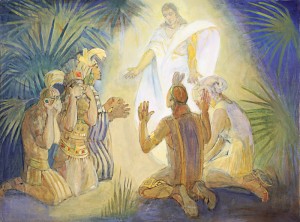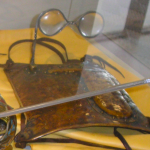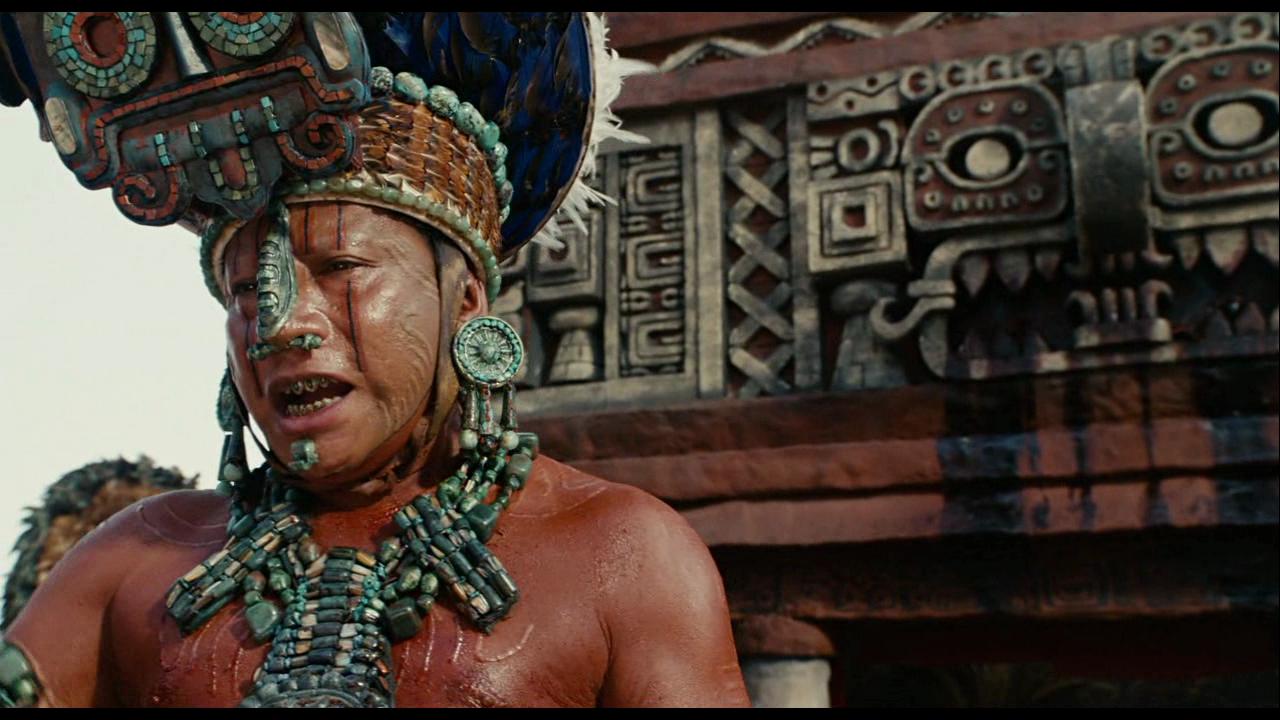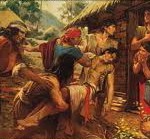BOOK OF MORMON LESSON 20: MOSIAH 25-28; ALMA 36
Reunion at Zarahemla
25:1 At this point, three separate narratives have come together: the people of Mosiah2, people of Limhi, and the people of Alma
25:2 The Number of Nephites was greatly reduced in Omni 1:5
25:5, 6 Here we read of the ceremonial sharing of records. The records of Zenif are found in Mosiah 9-10; the records of the people of Zeniff are in Mosiah 11, 19-22; the account of Alma1 and his brethren is found in Mosiah 12-18, 23-24
25: 12 Does the Book of Mosiah mention anywhere else the children of Noah’s priest, Amulon?
25:13 Does this exclusive Nephite right to leadership cause problems in Zarahemla? Could this have been the impetus for King Benjamin’s earlier address? Could this be the reason for the uprising of the Kings Men later in the Book of Mormon?
A Church Established in Zarahemla
25:17 Had King Limhi not been baptized before? Or, was this symbolic of a recommitment like we saw during “the Mormon reformation” in the 1860’s when members of the LDS church showed their recommitment to the church institution via re-baptism? We can assume Alma had been baptized before his self re-immersion in Mosiah 18:14. Why would Limhi not have been baptized earlier?
25:18 The word “church” is first used in 1 Nephi 4: 26 in connection to Nephi’s killing of Laban. After that Nephi’s record contains the word church again, but it is always in vision. After 2 Nephi 28:18 (great and abominable church), the word “church” does not show up until Mosiah 18:17. In the Book of Mosiah, church is used a bit differently than before. When we first encounter it in Nephi’s record, it is dealing with the organization in the Old World, he never uses it in the context of the New World; after leaving Jerusalem, it is only in vision that the word is used. In Mosiah, with Mormon as editor, “church” as an organization is re-intorduced, but it is in the context of the New World.
vs. 18 is also the fulfillment of one of Mormon’s editorial comments (editorial promise) in Mosiah 21:35
25:19 Why is Mosiah allowing Alma1 to establish churches and giving “him power to ordain priests and teachers over the church”? Why does Alma1 need Mosiah’s permission? Is the government a theocracy at this point? One of the arguments made against the Book of Mormon being an authentic historical record is that we see Joseph Smith’s world showing up in the Book of Mormon in the form of a democratic government with elected officials.
25:23 Here we get the clear doctrine that the Christ (Jesus) is also God. Are Mormons poly-theistic or mono-theistic? Supposedly the great distinction between the Abrahamic religions (Christianity, Judaism, Islam) and other religions is that the Abrahamic religions are mono-theistic. I would argue that Mormonism is poly-theistic.
Young Believers
26:1 Is Mormon attempting to draw a connection between unbelief and a lack of understanding of what King Benjamin spoke? Remember, that some of “the rising generation” did not live in Zarahemla when King Benjamin spoke (King Limhi’s people, Alma’s people, etc)
26: 4 “They would not be baptized; neither would they join the church.” Interesting statement. It appears that there is a distinction between baptism and becoming a member of the church. Or does the word “neither” have another implied meaning?
Questions of Church Discipline
26:15-32 Here we have the insertion of a primary document. We also learn something about transgression and church government. “and if he confess his sins before thee and me, and repenteth in the sincerity of his heart, him shall ye forgive.” (vs. 29) “whosoever will not repent of his sins the same shall not be numbered among my people.” (vs. 32)
26:25 No first trump was mentioned. Weird.
Alma1 Regulates the Church
26:37 Is Mormon attempting to draw a connection between sin, repentance, church discipline and peace? “In the affairs of the church,” is an interesting way to put things. Usually in the Book of Mormon, when people are righteous, there is a clear connection between righteousness and and material prosperity; Mormon doesnt’ seem to be doing that here.
An End to Persecutions
27:1 compare with Mosiah 26: 7 Are these the same priests? Or, does Alma1 have his own and King Mosiah have his own distinct set of priests?
27:3 This is an odd proclamation. Why on earth would the churches persecute themselves? It was coming from outsiders (27:1).
27:7 Now we get the standard Book of Mormon narrative of equating peace and righteousness with wealth.
Alma2 and the Sons of Mosiah are Rebuked by an Angel: Mosiah 27:8-27 & Alma 36
27:8 Mormon is so impressed with Alma2‘s rhetorical style that he includes several of Alma2‘s sermons verbatim.
Does it make a difference in the relationship of Alma and the sons of Mosiah that Alma is at least 10 years older than Mosiah’s sons? This can be surmised from the fact that Alma’s father was born about 37BC and Mosiah was born around 154 BC (Mosiah 29:45-46). Alma2 perhaps is the oldest or only son of Alma1.
27:10 What does Mormon mean by, “or even the king”? Is he saying that King Mosiah has edicts to his people in addition tot he commands of God, or is Mormon saying the commands of God and King Mosiah are the same?
 27:11 This same angel returns in Alma 8:14-15. Is this the same angel that commanded him to return to Ammoniah (Alma 8:15)? Does Alma2‘s famous exclamation, “Oh that I were an angel…” (Alma 29:1) have in mind the particular angel who spoke to him in Mosiah 27:11,15?
27:11 This same angel returns in Alma 8:14-15. Is this the same angel that commanded him to return to Ammoniah (Alma 8:15)? Does Alma2‘s famous exclamation, “Oh that I were an angel…” (Alma 29:1) have in mind the particular angel who spoke to him in Mosiah 27:11,15?
27:16 Why is the angel addressing only Alma and not the sons of Mosiah too?
Prayers for Alma2‘s Recovery
27:20, 21 If one of your children suddenly could not speak and not move, would you be happy and then have a bunch of people come and stare at him/her?
Alma2‘s Confession
27:24 “I have repented of my sins, and have been redeemed of the Lord.” This seems to be the first true conversion narrative in the Book of Mormon. Compare this narrative with the narrative Jacob presents of Shem in Jacob 7: 15-20 and that of Enos in the Book of Enos. Mormon as narrator and editor seems to be very concerned with Alma2‘s change of heart while Jacob seems to emphasize how Shem was deceived. Enos, by contrast, was already a good man.
Alma 36; Alma 38:6-8 Recount the same conversion narrative. The account in Alma 36 is quite interesting in that it is all given in 1st person while the account found in Mosiah 27 is given from the outsider looking in.
27:23-31 Here Jesus’ salvation is seen as individual. Compare this to Jesus’ corporate or collective salvation centered on the restoration of the House of Israel that He [Jesus] teaches to the people in Bountiful (3 Nephi 21:6; 30:2)
27:25, 28 The phrase,“Born again,” occurs 4 times in the Book of Mormon (Mosiah 27:25; Alma 5:49, 7:14(2x)); 3 times in the New Testament (John 3:3,7; 1 Peter 1:23) It never occurs in the Old Testament. “Born of God” Occurs 9 times in the Book of Mormon (Mosiah 27:25, 28; Alma 5:14, 22:15, 36:5, 23, 24, 26, 38:6), 6 times in the New Testament (all occurring in 1 John), and never occurring in the Old Testament.
Alma2 and the Sons of Mosiah Strengthen the Church
27:35 “The Lands of Zarahemla” seems to indicate that King Mosiah reigned over several areas and not just one city-state.
27:36 “Instruments in the hands of God.” This designation is acknowledged by both the narrator (Mormon) as well as Ammon himself in Alma 26:3, 15.
27:37 This is an example of one of Mormon’s editorial interruptions that Grant Hardy calls, “intensifying exclamations.”
The Sons of Mosiah2 Wish to Preach to the Lamanites
28:1 Does the record ever say anything more about the “small number” of people that go up to the Land of Nephi with the sons of Mosiah?
28:2 Notice that Mormon does not include anything about the skin color of the Lamanites. Was this a purposeful omission? If so, why would he have left it out while Nephi and Jacob included it?
28:7 The promise given to King Mosiah is seen being fulfilled in Alma 17:35. Here we see Mormon, as narrator, using prophecy to connect larger episodes and even books.
28:9 “And I shall give an account of their proceedings.” This is an editorial interuption that Grand Hardy calls an “editorial promise.“
Mosiah Translates the Plates Found by the People of Limhi
28:11 When Moroni compiled the Book of Ether, did he use King Mosiah’s translation or the primary text?
28:19 Editorial interruption called “editorial promise.” Even though Mormon gives the editorial promise, it is his son Moroni that gives the account.
With such an explicit declaration of intent, it is evident that Mormon’s work is not complete without some explanation of this mysterious, lost civilization, and the fact that the twenty-four plates were discovered in the midst of ruins littered with bones and weapons only heightens our curiosity (Mosiah 8:8-22). Yet judging from the editorial anxiety expressed by Moroni throughout the book of Ether, he found this inherited responsibility anything but easy. (Grant Hardy, Understanding The Book of Mormon, A Reader’s Guide, pg 227)
28:20 Mosiah Entrusts the Records to Alma2. In Omni 1:25 we read of a lateral transition (as opposed to a patrilineal transition) of the Small Plates of Nephi only; for King Benjamin already possessed the Large Plates of Nephi. Here in the Book of Mosiah we see a lateral transition of all the records to Alma2







mormonism is nothing but a deception and a devil worshiping acult